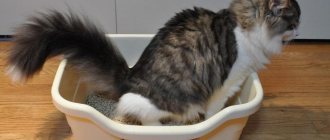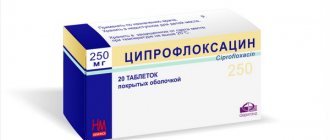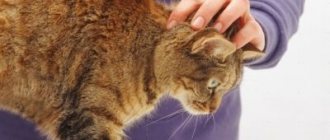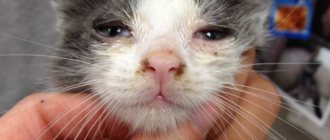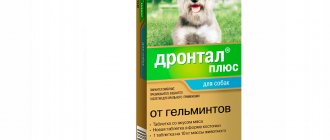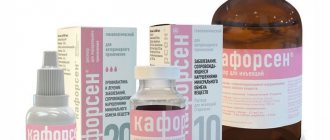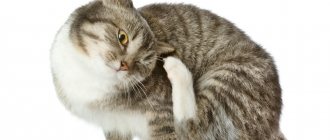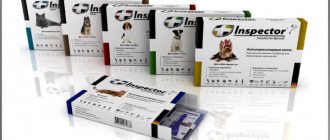Composition of the drug
The drug contains the following components:
- Belladonna extract. The plant itself is extremely poisonous, but in microscopic doses its extract helps reduce the sensitivity of the nervous system. Helps with spasms and cramps.
- Mountain arnica extract. It is equally widely used in veterinary medicine and medicine. Helps stop bleeding.
- Calendula extract. The ability of this plant to accelerate the regeneration of wounds has been known since ancient times. Excellent in treating ulcers, eczema and dermatitis, as well as wounds.
- Echinacea extract. Known as a powerful immunomodulator of natural origin. Noticeably enhances the overall tone of the body.
- The well-known ASD-2. A phenomenally “versatile” drug: enhances regeneration, accelerates and normalizes metabolic processes, enhances the body’s nonspecific resistance.
Storage conditions for the medicine
Since the drug contains many (in fact, the medicine consists of them) components of plant and animal origin, storage conditions must be observed very carefully:
- Let us immediately note that freezing the medicine is not recommended! Storage temperature should be maintained between 4° and 25° Celsius.
- The drug should always be stored so that it is not exposed to direct sunlight! Ultraviolet treatment has an extremely negative effect on the plant extracts that make up the medicine .
- In addition, during storage it is necessary to isolate the medicine from access of small children and pets. In principle, the drug is quite safe, but still its “immoderate” consumption can lead to unpleasant consequences.
The shelf life is exactly three years from the date of issue. If the bottle of medicine is opened, its contents must be used within three weeks.
Release forms
We list the main forms of release:
- Solution.
- Pills.
- Gel.
In the first case, the medicine is a clear, colorless liquid. The manufacturer reports that a slight yellowish tint is acceptable. It is unacceptable to use the drug with sediment. It is packaged in 10 ml and 100 ml bottles made of dark or light glass, sealed with rubber stoppers and additionally protected with aluminum caps.
Small bottles (10 ml each) are placed in cardboard packages of ten pieces each. The bottle and additional packaging always indicate the production date and expiration date. If this information is erased, blurred, or otherwise damaged, the medicine must not be used and must be discarded.
The drug is also available in the form of tablets, packaged in plastic bottles of various capacities. Much less often, “Travmatin” comes on sale in the form of a gel for oral use, which is packaged in plastic tubes.
"Travmatin" has the following properties:
- Significantly dulls and reduces the intensity of pain reactions of any etiology.
- The drug has a powerful antishock effect, which is especially pronounced when administered intravenously.
- Helps quickly stop bleeding and natural resorption of hematomas.
- Relieves swelling.
- Has a powerful anti-inflammatory effect.
- Slows down the spread of infection throughout the body and prevents the proliferation of pyogenic microflora.
- Accelerates healing processes.
- Normalizes and accelerates metabolism. This property, in particular, accelerates the pet’s recovery from anesthesia, and therefore the drug is actively used in the postoperative period, and is also prescribed before surgery.
Instructions for use Traumatina
The drug Travmatin is widely known in veterinary clinics as a highly effective, safe treatment for cats and dogs. Despite its effectiveness, the use of the drug requires compliance with the standards prescribed in the relevant instructions.
To achieve the desired result, it is important to carefully read the sections with indications and contraindications and understand the distinctive features of the methods of use.
Composition and release form
Travmatin is a homeopathic preparation of plant origin. Includes:
| Active ingredient | Functions |
| Arnica | Hemostatic effect, toning and strengthening the walls of blood vessels, preventing the development of sepsis, accelerating the healing of wounds and bruises |
| Chamomile | Rapid relief of acute pain, sedative effect, reduction of inflammation of the mucous membranes |
| Calendula | Effective fight against purulent wounds, acceleration of restoration of damaged tissues in lacerations, frostbite, burns |
| Echinacea | Strengthening the immune system, helping the body resist infectious diseases, preventing sepsis |
| St. John's wort | Pain relief, regeneration and restoration of the nervous system in case of damage to the spinal cord or brain, rupture of nerve fibers |
| Belladonna | Reduction of elevated temperature, acute pain, swelling, relief of heat and redness in acute localized inflammation |
| Sulfur calcium liver | Improving metabolic processes at the cellular level, launching regenerative processes, eliminating suppuration |
| Immunomodulator ASD-2 | Increasing tissue immunity, launching regeneration processes, improving blood circulation |
The auxiliary components of the medicine are water, ethyl alcohol and sodium chloride. Travmatin is available in the format of a clear, colorless solution for injections, a thick transparent gel, and tablets. Injections are given intravenously, subcutaneously, the gel is applied to the skin or affected areas, tablets are intended for oral use. The medicine is packaged in vials.
The principle of action of the drug
The drug eliminates pain of any nature; after injections there is no need to take other analgesics. Intravenous injections provide immediate anti-shock action. The drug stops bleeding, resolves swelling, hematomas, normalizes blood flow at the site of injury, stops inflammation, prevents wounds from festering, starts regeneration processes, and prevents the spread of infections in the body. By stimulating redox processes, the animal recovers from anesthesia faster and recovers after surgery.
- Ankle Bens salad from zucchini for the winter
- How to make spaghetti sauce: homemade recipes
- The most beautiful surnames in the world
Indications for use
Since the indications for use of the medicine are quite varied, they should be given a separate section.
General indications
The drug helps well with all types of injuries and burns, as well as with diseases accompanied by frequent bleeding. It is also prescribed for infectious pathologies. Although the medicine does not affect the causative agents of these pathologies, it contributes to the speedy recovery of the pet and its return to normal physical condition.
In practice, it has been proven that the product also helps to quickly and gently relieve traumatic swelling. For this reason, it is prescribed not only for injuries, but also in the postoperative period. It speeds up the cat’s recovery and mitigates the consequences of surgery. Finally, the drug is indicated for the treatment of pathologies of the respiratory system (including pneumonia and severe bronchitis).
Important note. Despite all its beneficial properties, “Travmatin” is not some kind of panacea. For any orthopedic pathology (or other serious illness), priority attention should be paid to specific drugs and techniques. Simply put, if a paw is broken, the medicine will only alleviate the cat’s condition, but it still won’t be possible without surgery!
Skin pathologies
The drug has proven itself especially well in the treatment of the following diseases:
- Burns of chemical and thermal etiology.
- Frostbite.
- All types of wounds.
- Many types of dermatitis and eczema of any etiology (bacterial, fungal, etc.). Regular use of the medicine accelerates skin healing by about 15%, promotes the rapid formation of granulation foci even with severe, non-healing ulcerative lesions of the skin.
Orthopedic pathologies
Also, “Travmatin” can be used in the treatment and prevention of pathologies of the bone, muscle, ligamentous and articular systems:
- Weight types of joint diseases (including arthritis and arthrosis). The medicine has a pronounced anti-inflammatory effect, relieving swelling and pain.
- Fractures. Even in this case, the drug helps by accelerating the formation of callus and bone tissue regeneration.
- Dislocations and similar injuries. And in this case, the medicine relieves swelling and alleviates the general condition of the animal.
Pathologies of inflammatory etiology
We have already repeatedly noted above that the product has a pronounced anti-inflammatory effect. It is not surprising that veterinarians often use it in the treatment of pathologies of inflammatory etiology:
- Pyoderma, abscesses.
- Inflammation of the mammary glands (i.e. mastitis).
- Purulent periodontal pathologies.
- Otitis (especially purulent).
Postnatal pathologies
Childbirth is a severe shock for the animal’s body, and in some cases it is the state of shock that causes the development of severe postpartum pathologies. Fortunately, Travmatin can significantly alleviate shock conditions. If the drug is administered intravenously immediately after birth, the cat’s condition will stabilize faster, and the likelihood of developing pathologies will become significantly less.
It is also used in cases where it was not possible to prevent the occurrence of pathologies. In particular, regular administration of Travmatin helps with endometritis, vaginitis, and other gynecological diseases.
The practice of veterinary obstetricians proves that with regular administration of the drug, the likelihood of infertility in cats is significantly reduced, even after severe endometritis.
Postoperative period
We recommend using “Travmatin” after any surgical interventions, since in these cases the effect is simply remarkable. The medicine accelerates and normalizes metabolism, due to which under-oxidized products are eliminated from the cat’s body much faster.
The product significantly reduces the toxic load on the liver and kidneys. The healing process of the surgical area is accelerated, the suture material is absorbed faster, and the risk of postoperative bleeding, thrombosis, and other dangerous pathologies is reduced several times.
Indications
Injections for dogs with Travmatin solution are prescribed if:
- various injuries - lacerations and cuts, burns, sprains, bruises, dislocations, fractures, cracks;
- skin diseases - eczema, dermatitis, etc.;
- acute inflammatory processes of any nature;
- recovery period after surgery;
- sun or heatstroke;
- childbirth and postpartum complications;
- benign and malignant tumors;
- joint diseases - arthritis, arthrosis, bursitis, etc. lack of sucking reflex in newborn puppies.
And also in the absence of a sucking reflex in newborn puppies.
Mode of application
Depends on the dosage form.
“Travmatin” in the form of a solution is administered exclusively parenterally ; subcutaneous, intravenous and intramuscular administration is allowed. In some cases, the solution is used for oral administration.
Tablets are used exclusively for oral administration. But we would like to dwell on several important nuances.
- The optimal place for subcutaneous injection is the area of the scapula. When the forelimb moves, the drug is “rubbed” into the subcutaneous tissue, causing its absorption and assimilation to occur much faster.
- For intramuscular injection, we recommend choosing the area of the gluteal muscles (for the same reasons - the medicine is absorbed faster). But still, veterinarians believe that the optimal method of administration is intravenous. In this case, the medicine begins to act almost immediately after entering the general bloodstream.
- When administered intravenously, Travmatin can be used as a means to provide emergency care to an animal (fractures, pain shock, etc.).
Note that with any method of parenteral administration the pain reaction is minimal. Moreover, the medicine itself reduces the intensity of the pain reaction, so the cat experiences minimal discomfort. As a result, the pet does not have a panicky fear of the veterinarian, and he is not so afraid of medical procedures.
The gel form is intended for external application. It is used, in particular, in the treatment of bruises, sprains, frostbite or burns, etc.
Analogs
Travmatin has no complete analogues. This is due to the fact that its herbal composition is not typical for other homeopathic remedies. Especially for ordinary people. But Travmatin, regardless of the form of release, can be replaced with one of the following:
| Name | Peculiarities | Price |
| Traumeel | A homeopathic remedy that is suitable for the treatment of wounds and demodicosis. The effect of Traumeel is faster than that of Traumatin. | From 300 to 500 rubles depending on the place of purchase. |
| Trauma gel | The drug is from the same manufacturer with a similar composition. It is available in the form of a gel and solution for injections. | From 190 to 1300 rubles depending on the dosage. |
| Target-T | The third homeopathic medicine for dogs is prescribed for disorders of the ligaments and joints. | From 280 to 1100 depending on the form of the drug. |
| Hondatron | This medicine is available in the form of an injection solution, tablets and gel. But it differs from Travmatin in that it is used for synovitis and bursitis. | From 200 to 400 Russian rubles, depending on the form of release. |
Dosage of the drug
To calculate the required dose, the owner does not need to have any veterinary skills, since the dosage of the drug is very simple:
- When administered by injection, 0.1 ml is required for each kilogram of the pet’s live weight. The dosage is the same for all animals, including kittens and old cats. Typically, injections are given twice a day with an equal interval between them. The duration of the standard course of treatment is ten days. When treating severe diseases, the duration of the therapeutic course can be significantly increased (up to one and a half months).
- In the case of tablets, up to two tablets are given per animal per day every 12 hours.
- The drug in the form of a gel is applied to the affected areas three times a day, spreading it in a thin layer and gently rubbing into the skin.
- In the case of obstetrics, the medicine is administered at the very beginning of the process and the administration is repeated four hours later. In the following days, the drug is used in the same way as described above.
- If the kittens do not have a sucking reflex and do not suck on their mother, they are given 3 drops of the solution every half hour until the reflex appears.
When using the injectable form of the medicine to treat kittens and young cats, we would advise not to administer more than 0.5 ml of solution per day. In severe cases (wounds, fractures, etc.), 1.5-2 ml of medication can be administered at once, regardless of the pet’s weight.
In the treatment of severe orthopedic pathologies and other diseases, the medicine can be used for up to six months or even longer. There is nothing wrong with this; there will be no serious consequences for the animal’s body.
Approximate application regimens (in the form of injections)
Below we provide a table that describes approximate scenarios for using the drug in the treatment of various pathologies.
| Indications for use | Frequency of intravenous injections |
| Burns, frostbite, wounds, other damage to the skin | Up to three times a day for a week |
| Obstetrics process | Injected before the onset of labor and four hours after it |
| Lack of sucking reflex in newborn kittens | Up to five drops every half hour |
| Breast inflammation | Up to three times a day for three weeks |
Features of the use of the medicine
Homeopathic medicines cannot completely heal the body, so Travmatin is usually prescribed in combination with other medicines. It is often used to treat cats, as it is believed that the plant components cannot harm.
Frequency and type of injections
The drug is administered intramuscularly or subcutaneously, but the frequency of injections depends on the purpose:
- For inflammation and injuries (including postoperative) 1–3 times a day for a week intramuscularly or subcutaneously.
- For the treatment of mastitis 2-3 times a day for 5-10 days subcutaneously.
- For obstetrics, prevention of complications - 1 time before childbirth and 3 hours after it, intramuscularly or subcutaneously.
- In the absence of a sucking reflex in kittens, 3-5 drops orally every half hour until the condition stabilizes.
Is it possible to give an injection at home yourself?
Not every cat owner can go to a veterinary clinic, which is why people look for information about cat treatment on the Internet. And sometimes it happens that the veterinarian prescribed treatment, but daily trips to the clinic can worsen the animal’s condition. In any of these cases, injections can be done independently.
I give all the injections to my cats myself. The main thing in such cases is not to be nervous, because cats sense the owner’s anxiety, and a hand trembling with fear may tremble. By the way, I always use insulin syringes. Their needles are shorter (and a cat doesn’t need a large needle to inject) and thinner, which means the injection will be less painful. In addition, the insulin syringe has a convenient division scale
And if I only have ordinary syringes in my medicine cabinet, then I try to find a small needle (it is important that everything is sterile)
It is more convenient to use insulin syringes to inject a cat - their needles are thinner and shorter
Usually, the owners give subcutaneous injections themselves, rather than intramuscular ones. It's much simpler and less secure. Even if you miss, the maximum harm is the spilled medicine. Travmatin's injection is not particularly painful, so the cat will not run away.
Here is the sequence of actions:
- Bend the edge of the notch on the bottle cap so that the rubber cap is visible.
- Draw the medicine into the syringe, release air bubbles (let a drop of solution appear at the tip of the needle).
- Secure the cat and make a fold on its neck with the fingers of your left hand.
- Quickly insert the needle 1–1.5 cm and gently press the syringe plunger.
- When all the solution has been injected, remove the needle without rocking the syringe from side to side.
- It is not necessary to rub the injection site.
Video: how to properly give an injection at the withers of a cat
Use in pregnant cats and kittens
In veterinary clinics, Travmatin is most often prescribed to pregnant or just given birth cats, since one of the indications for use is childbirth.
Veterinarians sometimes prescribe Travmatin to kittens, most often to newborns. For example, if the birth was difficult or protracted, and the kittens were born frail. Some babies may not show signs of life at all, but Travmatin is able to enhance cellular respiration and stimulate resistance, so even the weakest babies can perk up.
Travmatin is actively used to treat pregnant and postpartum cats, as well as weakened kittens.
Personal safety measures when in contact with the drug
When working with Travmatin, you must follow the general rules:
- Before injection and after contact with the drug, hands should be washed with soap.
- In case of accidental contact of the drug with the skin or mucous membranes of the eyes, they must be rinsed with plenty of water.
- People with hypersensitivity should avoid direct contact with the drug.
- In case of allergic reactions or accidental exposure of the drug to the human body, you should immediately contact a medical facility (bring with you the instructions for use of the drug or the label).
- Empty drug bottles must not be used for household purposes; they must be disposed of in a trash container.
My friends sometimes wonder why I give an injection without gloves, but in a medical mask. In fact, every allergy sufferer knows their own characteristics. For example, I have a respiratory reaction to alcohol derivatives, so I definitely need a mask. I don’t use gloves, because I wash my hands thoroughly with antibacterial soap and do injections very carefully (experience).
Side effects
As a rule, no side effects are observed when using the medicine in accordance with the above instructions for use. This is due to the fact that the drug belongs to the fourth class of danger, and therefore it can be prescribed to all categories of cats, including newborn kittens and lactating females, without any fear.
Only in extremely rare cases is individual intolerance to the components included in the drug possible. This usually happens in animals suffering from allergic reactions to vegetation. In such situations, the medication should be stopped immediately and antihistamines prescribed.
Contraindications
As we have already indirectly mentioned, the medicine has practically no contraindications. One of the few exceptions is animals prone to developing allergic reactions. In such cases, the drug should be used exclusively under the supervision of a veterinarian.
If the medicine accidentally gets into your cat's eyes, they should be rinsed immediately with plenty of water.
In other cases, irritation may develop. If there is a need to administer the drug to an animal suffering from hypersensitivity, use the minimum possible dosage. If signs of an allergic reaction appear (redness, swelling, itching, etc.), it is necessary to urgently stop administering the medication and immediately prescribe antihistamines to your pet.

